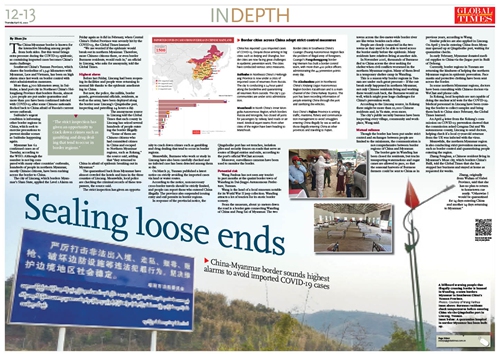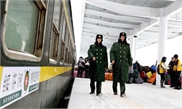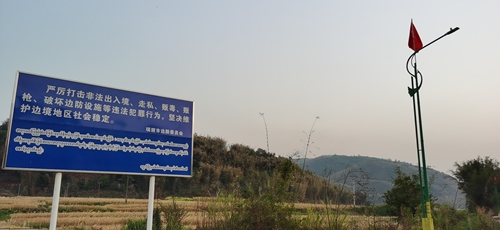
A billboard warning people that illegally crossing border is banned in Wanding, a town borders Myanmar in Southwest China's Yunnan Province. Photos: Courtesy of Wang Fanhua
The China-Myanmar border is known for the interactive blending among people from both sides. But this trend brings extra pressure during the COVID-19 epidemic, as containing imported cases becomes China's main challenge.Southwest China's Yunnan Province, which shares the borderline of 1,941 kilometers with Myanmar, Laos and Vietnam, has been on high alarm since last week on border control with strict administration measures.
More than 4,700 kilometers away, in Suifenhe, a land port city in Northeast China's Heilongjiang Province that borders Russia, almost 1,500 people are put under quarantine and more than 300 have been confirmed infected with COVID-19 after some Chinese nationals flocked back to China afraid of Russia's current severe outbreak.
Suifenhe's urgent condition is informing other border regions in China, which seek to exercise precautions to prevent similar scenes as Suifenhe happening again.
Myanmar has 62 confirmed cases as of Tuesday, according to the WHO. Although the number is not big compared with many other countries' outbreaks, hundreds of people in northern Myanmar, mostly Chinese citizens, have been rushing across the border to China.
The city of Lincang, which borders Myanmar's Shan State, applied the Level 1 Alarm on Friday again as it did in February, when Central China's Hubei Province was severely hit by the COVID-19, the Global Times learned.
"We are worried if the epidemic would break out in northern Myanmar. Therefore, more Chinese citizens there, or even border Burmese residents, would rush in," an official in Lincang, who asks for anonymity, told the Global Times.
Highest alarm
Before last Friday, Lincang had been reopening its facilities and people were returning to normal life thanks to the epidemic ameliorating in China.
But now, the police, the militia, border guards, governmental officials, residents, as well as the army, have been deployed along the border near Lincang's Qingshuihe port, inspecting and patrolling 24 hours a day.
The anonymous source in Lincang told the Global Times that each county in Lincang has seized several hundreds of people entering the border illegally.
"Some of them are Chinese citizens who had committed crimes in China and escaped to Northern Myanmar regions, such as Kokang," the source said, adding that "they returned to China in afraid of epidemic breaking out in Myanmar."
The quarantined back from Myanmar have almost crowded the hotels and inns in the three counties of Lincang. Meanwhile, local police are checking the criminal records of these trespassers, the source said.
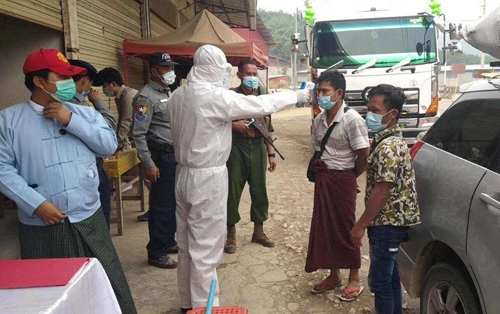
Burmese residents check temperatures before entering China via the Qingshuihe port in Lincang, Yunnan.
The strict inspection has given an opportunity to crack down crimes such as gambling and drug dealing that tend to occur in border regions.
Meanwhile, Burmese who work or study in Lincang have also been carefully checked and no infected case has been detected among them so far.
On March 31, Yunnan published a latest notice on strictly avoiding the imported cases via land or water routes.
According to the notice, non-necessary cross-border travels should be strictly limited, and people can report those who entered China illegally. The province also suspended issuing entry and exit permits in border regions.
In response of the provincial notice, the Qingshuihe port has set trenches, isolation piles and security fences on roads that serve as routes of illegal entries and exits, according to the port's official WeChat account.
Moreover, surveillance cameras have been used to monitor the border.
Potential risk
Wang Fanhua has not seen any tourist in past months at the quaint border town of Wanding in Dai-Jingpo Autonomous Prefecture, Yunnan.
Wang is the head of a local museum notable for its World War II jeep collection. Wanding attracts a lot of tourists for its exotic border scenery.
From the museum, about 50 meters down the road is a border gate connecting Wanding of China and Pang Sai of Myanmar. The two towns across the five-meter-wide border river are like twins besides each other.
People are closely connected in the two towns as they used to be able to travel across the border easily before the epidemic. Many residents have relatives living at another side.
In November 2016, thousands of Burmese fled to China across the river seeking for shelter when civil conflicts worsened in the northern Myanmar region. Many of them lived in a temporary shelter camp in Wanding.
This is a reason why border regions in Yunnan are under such great pressure - If the outbreak really happened in northern Myanmar, not only Chinese residents living and working there would rush back, the Burmese would as well, which might pose huge challenges for China's prevention work.
According to the Lincang source, in Kokang there might be more than 10,000 Chinese residents and, in Va state, even more.
The city's public security bureaus have been inspecting every village, community and workplace, Wang said.
Mutual reliance
Though the border has been put under strict control and exchanges between people are limited to the minimum, the communication is not comprehensive between border regions of China and Myanmar.
The border gate in Wanding has been closed for residents, but trucks transporting watermelons and sugar canes are allowed to pass, so that the seasonal harvests of Burmese farmers could be sent to China as in previous years, according to Wang.
Similar policies are also applied in Lincang. On April 7, trucks entering China from Myanmar queued up at Qingshuihe port, waiting for quarantine checks.
In early February, Myanmar donated medical supplies to China via the Jiegao port in Ruili of Dehong.
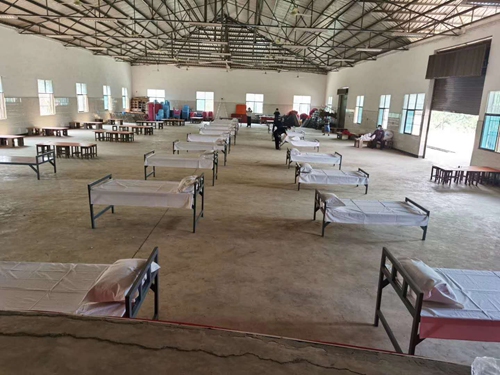
A quarantine hospital in norther Myanmar has been built up.
Currently, border regions in Yunnan are returning the kindness of helping the northern Myanmar region in epidemic prevention. Face masks and protective clothing have been sent across the border.In some northern Myanmar regions, doctors have been consulting with Chinese doctors via WeChat and phone calls.
In Kokang, local hospitals are not capable of doing the nuclear acid tests for the COVID-19. Medical personnel in Lincang have been crossing the border to collect samples and bring them back to China since February, the Global Times learned.
An April 4 letter from the Kokang's commission on COVID-19 prevention showed that the commission asked Gengma Dai and Wa autonomous county, Lincang to send doctors, helping check if a local 17-year-old returnee from the UK was infected with the virus.
Meanwhile, the northern Myanmar region is also conducting strict prevention measures, such as border control and quarantining people entering the region.
Zhang Fenghua, a Chinese resident living in Myanmar's Muse city, which borders China's Ruili, told the Global Times that she has stopped her business and stayed at home as requested for weeks.
Zhang, originally from Wuhan of Hubei Province, said that she has no plan to return to hometown currently. "Otherwise I would be quarantined for 14 days entering China and another 14 days returning to Myanmar."
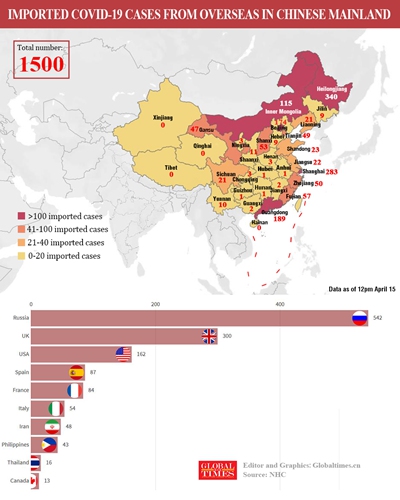
Graphics: GT
Sidebar: Border cities across China adopt strict control measures
China has reported 1,500 imported cases of COVID-19. Despite those arriving in big cities such as Beijing and Shanghai, border cities are now facing great challenges in epidemic prevention work. The cities have conducted various strict measures.
Suifenhe in Northeast China's Heilongjiang Province is now under a crisis of imported cases of returnees from Russia. The city is conducting a 24-hour patrol along the borderline and quarantining all returnees from outside. The city's 330 communities are under strict administration.
Manzhouli in North China's Inner Mongolia Autonomous Region, which borders Russia and Mongolia, has closed all ports for passengers by railway, land roads or air travel. Medical expert teams from other cities of the region have been heading to Manzhouli.
Border cities in Southwest China's Guangxi Zhuang Autonomous Region face the problem of illegal entry of foreigners. Guangxi's Fangchenggang bordering Vietnam has built a border control team, with more than 400 police officers administrating the 44 prevention points every day.
The Alashankou port in Northwest China's Xinjiang Uygur Autonomous Region borders Kazakhstan and is a main channel of the China Railway Express. The port has been recording information of people entering China through the port and sterilizing the vehicles.
East China's Fujian Province is uniting traffic, maritime, fishery and communication management to avoid smugglers entering China illegally by sea as well as those illegally entering China at other provinces and traveling to Fujian.
